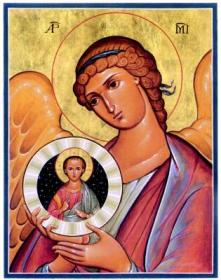 In addition, I spent a lot of time on my knees at the Lady Altar. I went through a period where I found it difficult to engage in intercessory prayer except at places dedicated to Mary, so I got into the habit of always praying here and at other shrines of Our Lady, such as the Guadalupe Shrine at St. Luke's, Bladensburg.
In addition, I spent a lot of time on my knees at the Lady Altar. I went through a period where I found it difficult to engage in intercessory prayer except at places dedicated to Mary, so I got into the habit of always praying here and at other shrines of Our Lady, such as the Guadalupe Shrine at St. Luke's, Bladensburg.As with most things in Anglo-Catholicism, Marian devotion requires a high degree of intentionality. It's not something you will find in most parishes of the Episcopal Church, and even in an Anglo-Catholic parish you might have to look for it. This points to one of the major differences I have found in Eastern Orthodoxy.
In the Orthodox Church, all of the things that Anglo-Catholics have had to work so hard to establish and maintain are just part of the base package, not optional extras. If you participate in any service at any Orthodox Church you're going to commemorate and request the intercession of "our all-holy, pure, most blessed, and glorious Lady Theotokos and Ever-Virgin Mary."
Theotokos is Mary's dogmatic title, which is most often translated as Mother of God, but might be rendered more precisely as Birthgiver of God or Godbearer. In honoring Mary as Theotokos we acknowledge both that her son is God and that he was born of a human mother, thus affirming the Church's teaching that Jesus is fully divine and fully human and that the divinity and humanity are perfectly joined in him. Those who refused to honor Mary as Theotokos were judged not to share the Church's understanding of the Incarnation, and they were excommunicated at the Council of Ephesus in AD 431. Conversely, my own devotion to Mary is tied closely to my commitment to the centrality of Christ's Incarnation.
Obviously, I am glad to be in a church where everyone joins in honoring Our Lady and begging her prayers. But no matter how extravagantly we honor her collectively, I am left feeling that I should do more. More generally: After cultivating a highly intentional devotional life as an Anglican, where is there room for that intentionality in my new Orthodox life?
As if to address my questions, Holy Cross just instituted a monthly Paraklesis service on the first Thursday of the month. This service is a supplication for the intercession of the Theotokos. Thus, it plays a role roughly equivalent to the Rosary for Anglo-Catholics. Naturally, I made a point of attending the first Paraklesis on Thursday evening, and I will try to do so regularly in the future.
From death and corruption he has saved
Most Holy Theotokos, save us.
My nature, held by death and corruption;
For unto death
He himself has surrendered;
For which reason, O Virgin, please intercede
With him who is your Lord and Son,
From the enemies' evils deliver me.


3 comments:
I guess I missed that the Paraklesis was a new, monthly thing. I thought it was just part of the Lenten package. Glad to hear it, though. FYI, Holy Apostles (ROCOR--I know, I know :-) in Beltsville has been doing a weekly Paraklesis (in the Russian tradition, Moleben) for as long as I've paid attention to their schedule. I think they suspend it for Lent, since there are extra services to perform.
Now that you mention it, I recall their telling me about the Moleben when I visited their open house. Thanks for the reminder!
BTW, the image accompanying this post is Our Lady of Walsingham, as rendered in a late medieval north Italian style by Philadelphia liturgical artist Davis D'Ambly. It is the central panel of the triptych that graces the Lady Altar at St. Paul's, K Street.
Post a Comment